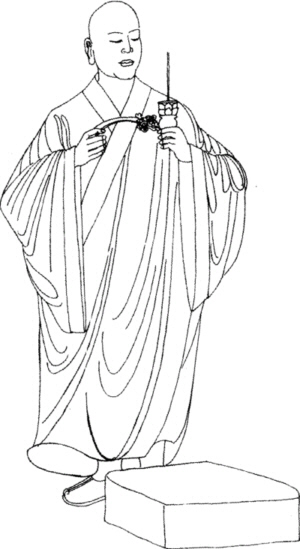Chapter 14 Section 2 Three Legs
The so-called "three feet" are one incense burner, one pair of candlesticks, and one pair of vases.According to the type, it is three, so it is called "three completes"; according to the number, it is five, it is called "five completes".This whole set is placed on the altar.It is called "five offerings" among the people.
It should be explained that such a set of donors is universal, or "owned by the whole people".It is not only used in Buddhism, but also in Taoism, and ordinary people also use it for sacrifices.In front of some large folk tombs in the Ming and Qing Dynasties, stone altars were placed in front of them, and the five altars were placed on the altars.Monks are generally cremated after Nirvana, and the ashes of eminent monks are put into the pagoda. There are no altars and three feet in front of the pagoda.
Furthermore, from a Buddhist point of view, the incense burner is the most important when worshiping.In the Dunhuang frescoes seen today, the donors and Bodhisattvas are almost all holding handle-type incense burners.In the picture of the saying, a tripod or pot incense burner is often placed in front of the Buddha, sometimes with a cover.
Typical murals of incense burners with handles, such as: the lower part of the south wall of Cave 397 in Dunhuang Mogao Grottoes, the murals of the Sui Dynasty, the second offering Bodhisattvas; the murals of the Sui Dynasty in Cave 303, offering monks; The murals of the Five Dynasties in Cave 98 show the King and Queen of Khotan; the murals in Cave 409 show the cigarette smoke rising from the censer with the handle held by the king of Xixia;

Monk holding an incense burner
In the murals of the Tang Dynasty seen today, there are already a furnace and another pair of utensils enshrined in front of the Buddha.For example, in the murals of the prosperous Tang Dynasty in Cave 445 of Mogao Grottoes, a furnace and a pair of pots are enshrined in front of Maitreya; Origin?); the murals of the Five Dynasties in Cave 61, and the murals of "Yao Shi Bian" in the Western Xia Dynasty in Cave 400, each with a furnace and another pair of offering vessels.
As seen in the prints, it is the frontispiece of the famous edition of the Diamond Sutra in the ninth year of Xiantong. In front of the Buddha is an incense burner with a cover, and on the left and right are a pair of pot-shaped vessels with tall feet and high lids.In the frontispiece of the Diamond Sutra annotated by Wuwen Monk in the engraved version from Yuan to Yuan, there is the same unmistakable combination of one furnace, two candlesticks, and two vases as today.
Displayed together with offerings, such as the illustration in the Hongzhi engraved edition of the Ming Dynasty in the Peking University Library, a piece of "Xiu Zhai Shi", three offering tables are listed: the front table has one incense burner, two candlesticks, and four tea cups; the middle table has Chen Gaozu bean offerings. There are five plates and six teacups; there are five plates and four flower pots for Chen Dagong on the table behind.From a modern point of view, it seems neither fish nor fowl, random arrangement.I'm afraid that's how it was set up back then.It must be noted that in the illustration of "The Story of the South Pipa" in the engraved Wanli edition of the Ming Dynasty, there is also a picture of one furnace, two vases and two long candlesticks juxtaposed in secular etiquette.It can be seen that the five offerings are utensils with the nature of the whole people, and they are not unique to monks.
As for the offerings, those often offered in ancient temples are nothing more than fruits, vegetarian snacks (including steamed buns, etc.), and some vegetarian dishes may be added.The flowers in the vase are sometimes replaced by fake flowers such as silk flowers.However, Tantric Buddhism does not allow the use of fake flowers, and there are various specialties in the use of raw flowers. There are many flowers that cannot be used; even the flowers that can be offered for offerings have to be different according to the different "ministries" and the types of practices.It is said that if the offered flowers do not wither for a long time, it shows that the sins of the supplicant have been eliminated.Especially after the fasting meeting, if some of the flowers that are scattered when spreading flowers are still fresh and tender, it shows that the invited Buddha and Bodhisattva were sitting there when they came to the meeting.
Candlesticks, modern electric lamp candlesticks are also useful, but they can prevent fire candles.
In addition, the ever-burning lamp in front of the Buddha, also known as the endless lamp and the long-lived lamp, is designed for the blessing of the donor.It is generally believed that it originated from the "Poor Girl Nanda Pin" in "The Sutra of the Worthy and Foolish".One day, she begged for a penny, bought enough oil to light a lamp, and went to the Gion Abode to make offerings to the Buddha.On the second day, all the lamps were extinguished, but the lamp of the poor girl was only on.Monk Mulian thought that there was no need to light the lamp during the day, and that if he wanted to extinguish the lamp, he couldn't.Buddha Sakyamuni said, this is a lamp lit by a person with great bodhicitta, and it cannot be extinguished by an arhat, even if it is poured with water from the four great seas, it will not be extinguished.Since then, the ever-burning lamp has been handed down.Later, this kind of lamp was also lit in the ancestral halls and other places of Chinese folk sacrifices, which was learned from Buddhism.

Monk holding an incense burner
